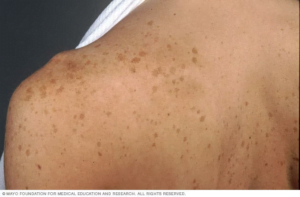Have you been struggling with rosacea, a common skin condition marked by facial redness and inflammation? Look no further – we have the perfect solution for you! Presenting “A Complete Guide to the Rosacea Diet Plan: Downloadable PDF.” This comprehensive guide offers valuable information on how to create a suitable diet plan that can help alleviate the symptoms of rosacea. Packed with expert advice and practical tips, this PDF will empower you to make informed choices about the foods you consume, ultimately leading to a happier, healthier complexion. So why wait? Download your copy of the Rosacea Diet Plan PDF today and embark on a journey towards clearer, radiant skin.

What is Rosacea?
Overview of Rosacea
Rosacea is a chronic inflammatory skin condition that primarily affects the face. It is characterized by redness, flushing, visible blood vessels, and small bumps or pustules on the skin. While the exact cause of rosacea is unknown, it is believed to be a combination of genetic and environmental factors. It typically affects adults between the ages of 30 to 50, and women are more commonly affected than men. It is important to note that rosacea is a chronic condition with no cure, but it can be managed through various treatments and lifestyle changes.
Causes of Rosacea
The exact cause of rosacea is still not fully understood. However, researchers believe that several factors may contribute to the development of this condition. These factors include genetics, abnormalities in the blood vessels, an overactive immune system, and the presence of certain bacteria on the skin. Additionally, environmental factors such as exposure to sunlight, extreme temperatures, and certain foods can trigger or worsen rosacea symptoms. It is important to note that what causes rosacea in one person may not necessarily cause it in another, as triggers vary from individual to individual.
Symptoms of Rosacea
Rosacea can present itself in various ways, and the severity of symptoms can differ from person to person. The most common symptoms of rosacea include persistent redness, flushing or blushing, visible blood vessels (telangiectasia), small red bumps or pustules, and a burning or stinging sensation on the skin. Some individuals may also experience dryness, itching, swelling, thickening of the skin, and eye problems such as dryness, redness, and irritation. It is important to consult a healthcare professional for an accurate diagnosis if you suspect you may have rosacea, as early intervention can help manage the symptoms effectively.
Understanding the Impact of Diet on Rosacea
Link Between Diet and Rosacea
While there is no specific diet that can cure rosacea, many individuals with this condition have noticed a correlation between their diet and the severity of their symptoms. Certain foods and beverages have been reported to trigger or worsen rosacea symptoms. However, it is important to note that triggers can vary from person to person, and not all individuals will experience the same reactions to certain foods. Keeping a food diary and tracking symptoms can help identify personal triggers and create a tailored diet plan for managing rosacea.
Foods that Trigger Rosacea
Though triggers can vary from person to person, some common foods and beverages have been known to trigger or worsen rosacea symptoms in a significant number of individuals. These triggers include spicy foods, hot beverages, alcohol, caffeine, high-glycemic index foods, processed and fried foods, and dairy products. These triggers often cause flushing, inflammation, and increased blood flow to the face, leading to the worsening of rosacea symptoms. Identifying and avoiding these trigger foods can help manage rosacea symptoms effectively.
Benefits of Rosacea Diet Plan
Following a rosacea diet plan can provide several benefits for individuals with rosacea. It can help reduce the frequency and severity of flare-ups, minimize inflammation and redness, improve skin health, and promote overall well-being. A well-designed rosacea diet plan can provide the body with essential nutrients while avoiding trigger foods, thus supporting the skin’s natural healing processes. Additionally, following a healthy diet can complement other treatment methods and enhance their effectiveness in managing rosacea.
Creating Your Rosacea Diet Plan
Consulting with a Healthcare Professional
When considering a rosacea diet plan, it is advisable to consult with a healthcare professional, such as a dermatologist or a registered dietitian. They can provide personalized guidance based on your specific triggers, symptoms, and overall health. They can also help identify any potential nutrient deficiencies and ensure that your diet plan is balanced and meets your nutritional needs. A healthcare professional can also address any concerns or questions you may have and monitor your progress throughout your journey with rosacea.
Identifying Trigger Foods
One of the crucial steps in creating a rosacea diet plan is identifying trigger foods. Keeping a food diary and noting down any changes in symptoms can help identify potential triggers. Common trigger foods for rosacea include spicy foods, hot beverages, alcohol, caffeine, high-glycemic index foods, processed and fried foods, and dairy products. However, it is important to note that triggers can vary from person to person. Once trigger foods are identified, they can be gradually eliminated from the diet to assess their impact on symptoms.
Designing a Balanced Diet with Rosacea-Friendly Foods
After identifying trigger foods, it is important to design a balanced diet that includes rosacea-friendly foods. These foods should be rich in nutrients that support overall skin health and reduce inflammation. Some examples of rosacea-friendly foods include healthy fats and omega-3s found in foods like fatty fish, avocados, and nuts, as well as lean proteins such as chicken, turkey, and tofu. Colorful fruits and vegetables, whole grains, and fiber-rich foods like legumes and seeds should also be incorporated into the diet. Additionally, including probiotics and fermented foods like yogurt and sauerkraut can promote gut health, which may indirectly benefit rosacea symptoms.

Rosacea Diet Plan: Foods to Include
Healthy Fats and Omega-3s
Including healthy fats and omega-3 fatty acids in your rosacea diet plan can support skin health and reduce inflammation. Foods rich in healthy fats include fatty fish like salmon and mackerel, avocados, olive oil, coconut oil, and nuts and seeds like almonds and chia seeds. Omega-3 fatty acids can also be obtained from fish oil supplements for individuals who struggle to incorporate enough omega-3 rich foods into their diet.
Lean Proteins
Incorporating lean proteins into your rosacea diet plan is essential for tissue repair and overall skin health. Opt for lean protein sources like skinless chicken and turkey, tofu, legumes, and eggs. These protein sources are not only nutritious but also low in fat, making them an ideal choice for individuals with rosacea.
Colorful Fruits and Vegetables
Colorful fruits and vegetables are rich in antioxidants, vitamins, and minerals, all of which contribute to skin health. Incorporate a variety of colorful fruits and vegetables into your rosacea diet plan to ensure a good balance of nutrients. Examples include berries, citrus fruits, leafy greens, bell peppers, broccoli, and sweet potatoes.
Whole Grains and Fibers
Whole grains and fiber-rich foods are not only beneficial for gut health but can also support overall well-being. Opt for whole grains like oats, quinoa, and brown rice, as well as fiber-rich foods such as legumes, lentils, and flaxseeds. These foods can help regulate blood sugar levels and promote a healthy digestive system, indirectly benefiting rosacea symptoms.
Probiotics and Fermented Foods
Probiotics and fermented foods can help promote a healthy gut, which has been linked to improved skin health. Include yogurt, kefir, sauerkraut, and kimchi in your rosacea diet plan to introduce beneficial bacteria into your digestive system. These foods can help support your body’s immune response and reduce inflammation, potentially improving rosacea symptoms.
Rosacea Diet Plan: Foods to Avoid
Spicy Foods and Hot Beverages
Spicy foods and hot beverages have been reported as common triggers for individuals with rosacea. Avoid foods like chili peppers, hot sauces, and dishes with excessive spices to reduce the risk of triggering rosacea symptoms. Similarly, hot beverages like coffee and tea should be consumed in moderation or replaced with milder alternatives like herbal teas or room temperature beverages.
Alcohol and Caffeine
Alcohol and caffeine are commonly reported trigger foods for individuals with rosacea. These substances can dilate blood vessels and cause flushing and redness. It is advisable to limit or avoid alcoholic beverages such as wine, beer, and spirits, as well as drinks and foods containing caffeine, like coffee, tea, chocolate, and energy drinks.
High Glycemic Index Foods
High glycemic index foods, which cause a rapid spike in blood sugar levels, have been associated with worsening rosacea symptoms. Sugary foods, refined grains, and processed snacks are examples of high glycemic index foods that should be limited or avoided in a rosacea diet plan. Opt for low glycemic index alternatives like whole grains, fruits, and vegetables to help maintain stable blood sugar levels.
Processed and Fried Foods
Processed and fried foods are commonly linked to inflammation and can potentially aggravate rosacea symptoms. These foods are often high in unhealthy fats, sodium, and preservatives, which can negatively impact skin health. Opt for fresh, whole foods and choose cooking methods like baking, grilling, or steaming instead of frying to maintain the nutritional value of the ingredients.
Dairy Products
Dairy products have been reported as triggers for some individuals with rosacea. While not everyone with rosacea is sensitive to dairy, it is advisable to monitor your consumption of dairy products and observe any changes in symptoms. If dairy products worsen your rosacea symptoms, consider alternatives such as almond milk, coconut milk, or oat milk.
Meal Planning and Recipes for Rosacea Diet Plan
Breakfast Ideas
For a rosacea-friendly breakfast, try a bowl of oatmeal topped with fresh berries and a sprinkle of chia seeds. Alternatively, enjoy a vegetable omelet made with egg whites, spinach, and bell peppers. Adding a side of avocado or a small handful of nuts can provide healthy fats and additional nutrients.
Lunch and Dinner Recipes
For lunch or dinner, consider grilling or baking lean proteins like chicken or fish, and serving them with a side of roasted vegetables and quinoa. Another option is to make a salad using mixed greens, cherry tomatoes, cucumbers, and grilled tofu or chickpeas. Dress the salad with a homemade vinaigrette made from olive oil, lemon juice, and herbs for added flavor.
Snack Options
When it comes to snacks, opt for fresh fruits like apples, grapes, or melons, or raw vegetables like carrot sticks or cherry tomatoes. Pair them with a small serving of hummus or Greek yogurt for an additional protein boost. Nuts and seeds, such as almonds or pumpkin seeds, can also make for healthy and satisfying snack options.
Beverage Choices
In terms of beverages, choose herbal teas like chamomile or peppermint, which can have a calming effect on the body and reduce inflammation. Infused water with slices of cucumber or lemon can also be a refreshing and hydrating choice. Remember to avoid hot beverages and caffeine-rich drinks as much as possible.
Incorporating Lifestyle Changes for Better Rosacea Management
Stress Reduction Techniques
Stress is often cited as a trigger for rosacea flare-ups. Incorporating stress reduction techniques into your daily routine can help manage and reduce the impact of stress on your skin. Practice relaxation techniques like deep breathing exercises, meditation, yoga, or engaging in hobbies that bring joy and relaxation. Additionally, getting enough sleep, maintaining a healthy work-life balance, and seeking support from friends, family, or a therapist can also contribute to stress reduction.
Exercise and Physical Activity
Regular exercise and physical activity can play a significant role in managing rosacea symptoms. Engaging in low-impact exercises like walking, swimming, or cycling can improve circulation, reduce stress, and promote overall well-being. However, it is important to pay attention to your body’s response to exercise, as intense workouts or exposure to extreme temperatures may trigger rosacea flare-ups in some individuals.
Skincare Routine Tips
In addition to dietary and lifestyle changes, a proper skincare routine can help manage rosacea symptoms and promote healthy skin. Use gentle, fragrance-free cleansers and moisturizers that are specifically formulated for sensitive skin. Avoid harsh scrubs or exfoliants that can irritate the skin. Opt for mineral-based sunscreens and wear a wide-brimmed hat and sunglasses when exposed to the sun. Finally, avoid using hot water on your face, and gently pat your skin dry instead of rubbing it.
Supplements to Support Rosacea Diet
Vitamin C
Vitamin C is a powerful antioxidant that can help reduce inflammation and support skin health. Consider incorporating vitamin C-rich foods into your rosacea diet, such as citrus fruits, strawberries, and bell peppers. If needed, a vitamin C supplement can also be taken under the guidance of a healthcare professional.
Vitamin D
Vitamin D plays a vital role in the immune system and may help reduce inflammation associated with rosacea. Foods rich in vitamin D include fatty fish like salmon and mackerel, egg yolks, and fortified dairy products. If necessary, a vitamin D supplement can be considered, especially for individuals with limited sun exposure or those with low vitamin D levels.
Zinc
Zinc is an essential mineral that supports the immune system and has anti-inflammatory properties. Including zinc-rich foods like shellfish, lean meats, legumes, and seeds in your rosacea diet can help support your skin health. If your zinc levels are low, a zinc supplement can be taken after consulting with a healthcare professional.
Omega-3 Supplements
Omega-3 fatty acids have been shown to reduce inflammation and improve overall skin health. While it is ideal to obtain omega-3s from food sources like fatty fish, individuals who struggle to consume enough omega-3 rich foods can consider taking an omega-3 supplement. These supplements typically come in the form of fish oil capsules, but there are also plant-based alternatives available for those following a vegetarian or vegan diet.
Tracking Progress and Making Adjustments
Monitoring Rosacea Symptoms
Throughout your journey with the rosacea diet plan, it is important to closely monitor your rosacea symptoms. Keep a record of any changes or improvements you notice in your skin, as well as any flare-ups or triggers you identify. This information will help you understand what works best for your skin and enable you to make any necessary adjustments to your diet and lifestyle as needed.
Seeking Professional Guidance
While the rosacea diet plan provides a general guideline, it is important to remember that everyone’s experience with rosacea is unique. Seeking guidance from a healthcare professional, such as a dermatologist or a registered dietitian, is crucial for personalized advice and support. They can help address any specific concerns, offer tailored recommendations, and provide supervision as you navigate your rosacea management.
Adapting the Diet as Needed
As your understanding of your personal triggers and dietary needs evolves, you may find it necessary to make adjustments to your rosacea diet plan. You may discover additional trigger foods or find that certain foods that were once triggers no longer affect your symptoms. By staying attentive to your body’s responses and seeking professional guidance when needed, you can continually modify and optimize your diet plan to support your overall well-being and rosacea management.
Conclusion
While there is no cure for rosacea, a well-designed rosacea diet plan can play a significant role in managing the condition and reducing its impact on your daily life. By identifying trigger foods, incorporating rosacea-friendly foods, and making necessary lifestyle changes, you can support your skin’s health and reduce symptoms. Remember to consult with a healthcare professional for personalized guidance and support throughout your journey. With patience, perseverance, and the right approach, you can effectively manage your rosacea and enjoy a better quality of life.


